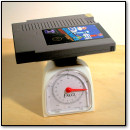[ Retro Scan of the Week ] Get Your Start in Color Computing with the TRS-80 MC-10
Monday, May 11th, 2015 SMALL ENOUGH TO FIT IN A DINOSAUR SHOE
SMALL ENOUGH TO FIT IN A DINOSAUR SHOE
I’ve owned a TRS-80 MC-10 since at least 1996 (according to this photo), so it holds a nostalgic place in my collection. It’s a really neat little machine despite its limitations (chief among those problems? Tiny chiclet keyboard). But Radio Shack designed this machine as a low-cost entry-level PC for the home, so most of of those issues can easily be overlooked.
The MC-10’s price at the time of this catalog printing had slipped to just $79 (about $178 today when adjusted for inflation). For comparison, the Apple IIc (a far more sophisticated machine, but typical for a home PC at the time) retailed for $1295 upon its introduction that same year (that’s a whopping $3,688 today). Price wise, that’s similar to the difference between buying a low-end Windows 8 tablet and a Mac Pro. The technological difference was not nearly that dramatic, however.
Perhaps the coolest thing about the MC-10 is that you can now download software for it over the Internet in the form of audio files and load them into the MC-10 via its cassette port. Check out this site for an awesome array of homebrew MC-10 games.
Discussion Topic of the Week: If you were stuck on a desert island and you could only use a TRS-80 MC-10 or a Sinclair ZX81, which would you pick?














